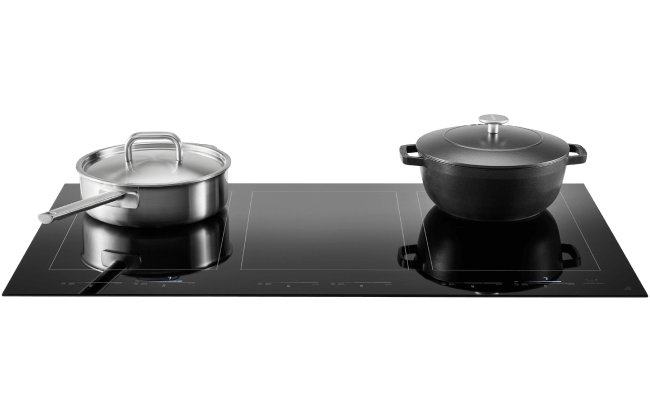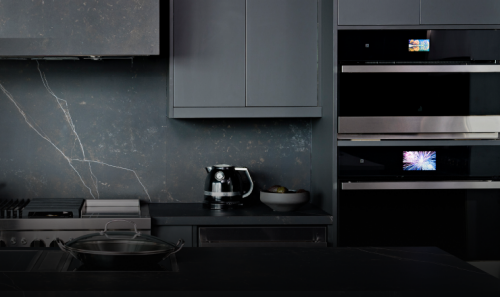

LEARN TO USE AN INDUCTION COOKTOP OR STOVETOP
Adding an induction cooktop to your kitchen allows you to eliminate the ordinary and add a dash of spectacular.
Thanks to the precision of a gas cooktop and the sleek aesthetic of a smooth glass surface, these cooktops can elevate any space and meal.
Induction cooking is unique, working differently than other fuel types. Understanding how to use an induction cooktop effectively can ensure you get the most out of your appliance.
Read this guide to master the art of induction cooking.
TABLE OF CONTENTS
HOW IT DIFFERS
How does induction differ from standard heating?
POTS AND PANS
What pots and pans can be used on an induction cooktop?
HOW TO TEST
How to test if a pan is induction-compatible
HOW TO COOK
Steps to use an induction cooktop
HOW DO INDUCTION COOKTOPS DIFFER FROM OTHER COOKTOPS?
Induction cooktops differ from other cooktops in a few ways but there is one distinct difference.
Non-induction cooktops act as heat sources, producing the necessary temperature to cook food whereas induction cooking doesn’t act as the heat source. Instead, it transforms cookware into a heat source via electromagnetic energy generated by a copper coil beneath the surface. This quickly heats the cooktop, allowing it to reach boiling temperatures and then rapidly cools the surface once the cookware has been removed.


CAN YOU USE STANDARD POTS AND PANS ON YOUR INDUCTION COOKTOP?
For induction cooking, you can only use pots and pans made with induction-compatible materials, like enamelled steel, cast iron and certain stainless steel materials.
Luckily, most standard pots and pans are made of these materials.
HOW TO TEST IF YOUR PANS ARE INDUCTION-COMPATIBLE
Test whether your cookware is compatible with an induction cooktop by holding a magnet up against the bottom of a pot or pan. If the magnet sticks, then you have confirmed that the pot or pan is made of ferromagnetic material and is compatible with your induction cooktop.
The pan size is also critical to achieving the desirable results. Use compatible cookware with a base diameter equal to the size of the heating element you intend to use.
HOW TO COOK ON AN INDUCTION COOKTOP
There are a few differences between using an induction cooktop and a gas or electric cooktop.
Review these comprehensive instructions to enjoy the precision and simplicity of induction cooking.
Please note that you should always refer to your owner’s manual for your model’s specific operating instructions.
WHAT IS NEEDED FOR INDUCTION COOKING:
- An induction cooktop, like the JennAir® lustre 30" induction flex cooktop
- Induction-compatible cookware. This cookware must be made from a ferromagnetic material, like enamelled steel, cast iron or induction-ready stainless steel.

STEP 1: ACTIVATE THE COOKTOP
The first step is to turn on your cooktop. Press the Power button located on the cooktop’s control panel. You should see an indicator light above the control panel signal that the appliance has been activated.

STEP 2: PUT THE COMPATIBLE COOKWARE ON THE HEATING ELEMENT
It’s mandatory to exclusively use compatible cookware on induction cooktops. Compatible cookware is made of ferromagnetic materials like enamelled steel, stainless steel designed for induction cooktops or cast iron. Other materials will not work on induction cooktops.
For this step, simply place the compatible cookware on the heating element.

STEP 3: ACTIVATE THE SURFACE COOKING AREA
Use the control panel to activate a cooking area. If it’s turned on, you should notice:
An illuminated power level indicator
A timer has begun
Most models are equipped with a function where the power automatically turns off after one minute of inactivity. This means that you must make your selections rather quickly.

STEP 4: SELECT A COOKING FUNCTION
Choose a heat setting on the control panel. Always refer to your owner’s manual for information about your model’s specific cooktop’s heat settings and functions.
With your induction cooktop ready to heat, it’s time to start cooking. Remember, induction cooktops heat quickly, so it’s recommended to closely monitor your food for doneness to avoid overcooking or burning.

STEP 5: TURN OFF THE COOKTOP
Once your food has achieved your desired doneness, press the ON/OFF button. This will turn off your surface cooking area. Next, press the power button to turn off the cooktop.
Before cleaning up, note the display for the Hot Surface Indicator. This indicator light will turn on if the surface area is very hot, even after the cooktop has been off for a bit.
EXPLORE JENNAIR® INDUCTION APPLIANCES


DISCOVER JENNAIR® INDUCTION COOKTOPS
Indulge in a heightened aesthetic with high-end appliances like JennAir® induction cooktops. Select models of induction cooktops have features like striking and intuitive Emotive Controls or the Bridge Function that combines two heating elements into one.
EXPLORE HIGH-END KITCHEN APPLIANCES WITH JENNAIR BRAND
-
 October 17, 2022 | 6 min read The Wall Oven Sizing Guide Discover how to choose a wall oven that is suitable for your kitchen by understanding its dimensions.
October 17, 2022 | 6 min read The Wall Oven Sizing Guide Discover how to choose a wall oven that is suitable for your kitchen by understanding its dimensions. -
 October 17, 2022 | 5 min read The Built-in Kitchen Appliance Guide You might be wondering: are built-in appliances worth it? This helpful Built-in Kitchen Appliances Guide may help you decide.
October 17, 2022 | 5 min read The Built-in Kitchen Appliance Guide You might be wondering: are built-in appliances worth it? This helpful Built-in Kitchen Appliances Guide may help you decide. -
 August 20, 2025 | 5 min read Kitchen Appliances For High-End Homes A complete guide for high-end kitchen appliances. Explore built-in refrigerators, wall ovens, cooktops & more. Add a high-end appliance to your kitchen today!
August 20, 2025 | 5 min read Kitchen Appliances For High-End Homes A complete guide for high-end kitchen appliances. Explore built-in refrigerators, wall ovens, cooktops & more. Add a high-end appliance to your kitchen today!
Compare 0/3
